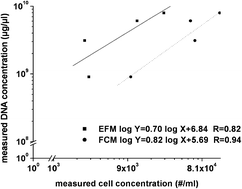Real-time quantitative PCR with gene probe, fluorochrome and flow cytometry for microorganism analysis
Abstract
Microorganism concentrations and viability can be better understood and clarified by using both culture and non-culture methods. Here, using pure suspensions of E. coli, three non-culture methods, namely, flow cytometry (FCM), epifluorescence microscopy (EFM), and real-time quantitative polymerase chain reaction (real-time qPCR), were compared with a traditional culture-based method. Using fluorocome-labeling methods with FCM and EFM applications, acridine orange (AO) and propidium iodide (PI) dyes were used to determine the total cell concentration and microorganism viability, respectively. The results indicated that total cell concentrations determined using FCM were statistically higher (2.62–4.94 times) than those determined using EFM. The difference might be due to cell losses induced by extensive preparations needed for EFM. In addition, EFM and FCM were highly associated for both the total cell concentration and viability. FCM-measured viability was the highest, whereas the culture-measured viability was the lowest. Furthermore, DNA concentrations measured by real-time qPCR with gene probe were highly associated with the total number concentrations measured by either the EFM or FCM. In summary, the three non-culture methods compared here could provide rapid and accurate information about microorganism concentrations and viabilities.


 Please wait while we load your content...
Please wait while we load your content...